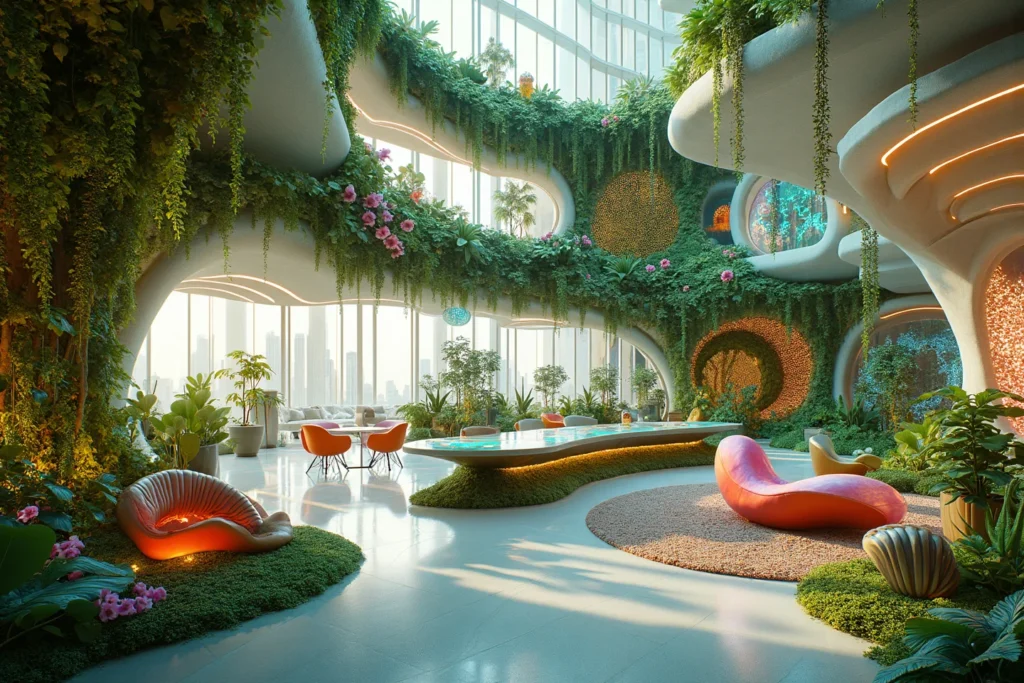
Lorem ipsum dolor sit amet, consectetur adipiscing elit. Ut elit tellus, luctus nec ullamcorper mattis, pulvinar dapibus leo.
Biomimicry is innovation inspired by nature. In a society accustomed to dominating or 'improving' nature, this respectful imitation is a radically new approach, a revolution really. Unlike the Industrial Revolution, the Biomimicry Revolution introduces an era based not on what we can extract from nature, but on what we can learn from her.
Janine Benyus
encapsulates the essence of biomimicry and suggests why we should apply it to our indoor environments. By learning from and emulating nature’s time-tested patterns and strategies, we can create more sustainable and efficient designs. Benyus further emphasizes the potential of biomimicry:
The answers to our questions are everywhere; we just need to change the lens with which we see the world.
Applying this principle to indoor environments, we can reimagine our living and working spaces to be more in harmony with nature’s principles. This approach could lead to improvements in energy efficiency, air quality, and overall well-being of occupants.
Benyus defines biomimicry as “innovation inspired by nature”
She emphasizes that this approach represents a radical shift from dominating or ‘improving’ nature to learning from it. Her philosophy centers on the idea that nature has already solved many of the problems we are grappling with today.

Janine Benyus is an American biologist, inventor, and climate activist who has made significant contributions to the field of biomimicry. She is renowned for her work in promoting nature-inspired innovation and sustainable design principles.
It’s important to note that while Benyus is credited with coining the term “biomimicry” and bringing it to the forefront, the idea of learning from nature has earlier roots. For instance, in 1957, Otto Schmitt, a bioengineer and physicist, proposed the word “biomimetics” to define a device that imitated the electrical action of a nerve
Similarly, Jack Steele defined “bionics” as the science of natural systems around the same time
Benyus’s work, however, has been instrumental in developing biomimicry into a comprehensive approach and methodology for sustainable innovation, inspiring designers, engineers, and scientists to look to nature for solutions to human challenges.
Biomimicry has inspired several practical applications in products that contribute to creating healthier indoor environments. Here are some notable examples:

Plant-Inspired Air Purifiers:
Drawing inspiration from how plants naturally purify air, some air purification systems incorporate principles of phytoremediation. These systems use plants or plant-based materials to remove volatile organic compounds (VOCs) and other pollutants from indoor air
This approach not only improves air quality but also adds aesthetic value to indoor spaces.
Biomimicry in water filtration has led to innovative solutions for home drinking water systems, offering more efficient and sustainable purification methods. Here are some practical applications of biomimicry in home water filtration:
Aquaporin-Based Membranes:
Aquaporin Inside® technology, developed by the Danish company Aquaporin, utilizes naturally occurring aquaporin proteins to create highly efficient water filtration membranes.
These proteins, found in all living organisms, act as selective water channels that allow only water molecules to pass through.
Moisture Absorption Inspired by Ticks:
Some dehumidification systems use a liquid desiccant dehumidifier that mimics the way brown dog ticks absorb moisture from the air. This biomimetic approach helps in controlling indoor humidity levels, which is crucial for maintaining a healthy indoor environment
Termite Mound-Inspired Ventilation: The Eastgate Centre in Zimbabwe demonstrates how termite mound-inspired design can be applied to create naturally ventilated buildings. This system uses a series of air pockets to drive natural ventilation through convection, significantly reducing energy consumption compared to conventional air-conditioning systems.
Bird-Inspired Heat Exchangers: Some cooling systems incorporate countercurrent heat exchange principles inspired by birds like ducks and penguins. This design maximizes efficiency in heating and cooling systems, potentially leading to more energy-efficient climate control in buildings.
Bioluminescence-Inspired Lighting: While not directly mentioned in the search results, some companies are developing lighting solutions inspired by bioluminescent organisms. These lights can provide softer, more natural illumination that may be less disruptive to human circadian rhythms.
Self-Cleaning Surfaces: Inspired by the lotus leaf’s hydrophobic properties, some building materials and coatings have been developed to repel water and dirt. This can help maintain cleaner indoor surfaces with less use of chemical cleaners.
Biophilic Design: Incorporating indoor plants into building spaces not only improves aesthetics but also helps purify air by removing VOCs. This approach, inspired by nature’s air-cleaning mechanisms, can significantly improve indoor air quality and occupant well-being.

Suite 115, Al Joud Center
Sheik Zayed Road
Dubai, UAE
Call or WhatsApp: 04 321 5505
Email: frontdesk@saniservice.com
Copyright © 2025 Saniservice Store | Powered by Nature